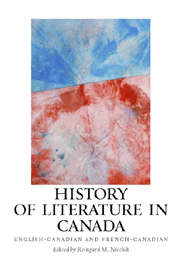Book contents
- Frontmatter
- Contents
- Acknowledgments
- Introduction: Writing a History of Literature in Canada
- I Beginnings
- II The Literature of New France, 1604–1760
- III The Literature of British Canada, 1763–1867
- IV From the Dominion to the Territorial Completion of the Nation, 1867–1918
- V The Modern Period, 1918–1967
- 11 Politics and Literature between Nationalism and Internationalism
- 12 English-Canadian Poetry, 1920–1960
- 13 The English-Canadian Novel and the Displacement of the Romance
- 14 The Modernist English-Canadian Short Story
- 15 Early English-Canadian Theater and Drama, 1918–1967
- 16 French Canada from the First World War to 1967: Historical Overview
- 17 French-Canadian Poetry up to the 1960s
- 18 The French-Canadian Novel between Tradition and Modernism
- 19 The French-Canadian Short Story
- 20 French-Canadian Drama from the 1930s to the Révolution tranquille
- VI Literature from 1967 to the Present
- Further Reading
- Notes on the Contributors
- Index
11 - Politics and Literature between Nationalism and Internationalism
from V - The Modern Period, 1918–1967
Published online by Cambridge University Press: 12 September 2012
- Frontmatter
- Contents
- Acknowledgments
- Introduction: Writing a History of Literature in Canada
- I Beginnings
- II The Literature of New France, 1604–1760
- III The Literature of British Canada, 1763–1867
- IV From the Dominion to the Territorial Completion of the Nation, 1867–1918
- V The Modern Period, 1918–1967
- 11 Politics and Literature between Nationalism and Internationalism
- 12 English-Canadian Poetry, 1920–1960
- 13 The English-Canadian Novel and the Displacement of the Romance
- 14 The Modernist English-Canadian Short Story
- 15 Early English-Canadian Theater and Drama, 1918–1967
- 16 French Canada from the First World War to 1967: Historical Overview
- 17 French-Canadian Poetry up to the 1960s
- 18 The French-Canadian Novel between Tradition and Modernism
- 19 The French-Canadian Short Story
- 20 French-Canadian Drama from the 1930s to the Révolution tranquille
- VI Literature from 1967 to the Present
- Further Reading
- Notes on the Contributors
- Index
Summary
IN 1926 THE POET A. J. M. SMITH (1902–1980) found Canada immersed in “an age of change, and … a change that is taking place with a rapidity unknown in any other epoch.… Ideas are changing and therefore manners and morals are changing. It is not surprising, then, to find that the arts, which are an intensification of life and thought, are likewise in a state of flux” (“Contemporary Poetry”). At this point in its history, Smith argued, the forces of modernization had already transformed the country so thoroughly as to infuse it with a new zeitgeist, engendering both a specifically modern mindset (unheard-of ideas, manners, and morals) and an equally iconoclastic artistic scene. While Smith's assessment — with the verve and rhetoric of a modernist innovator — eclipses the many premodern continuities in Canadian society, culture, and artistic practice at the time, it is certainly right in diagnosing “a nation in ferment” (Pacey 1976, 119). In fact, it was the collective experience of change — induced by closely intertwined political, economic, social, and cultural developments — which gave fresh momentum to the idea of a Canadian nation in the first place. Building on the milestone of Confederation, the first half of the twentieth century saw a refueled debate on the merits and drawbacks of national autonomy, with agendas of political and cultural nationalism forming a sometimes harmonious, sometimes conflictual alliance. Given Canada's particularly entangled position as a simultaneously bicultural, colonial, and North American country, these discussions mainly evolved within the triangle of nationalist, internationalist, and continentalist orientations and ambitions.
- Type
- Chapter
- Information
- History of Literature in CanadaEnglish-Canadian and French-Canadian, pp. 149 - 158Publisher: Boydell & BrewerPrint publication year: 2008

